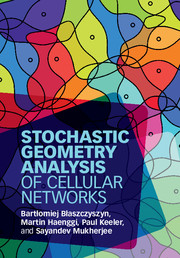Book contents
- Frontmatter
- Contents
- Preface
- Acknowledgments
- Notations
- List of Acronyms and Abbreviations
- Part I Stochastic Geometry
- Part II SINR Analysis
- Concluding Remarks
- Appendix A Proof of Lemma 5.3.6
- Appendix B Timeline of Cellular Technology Generations
- Appendix C Some Useful Probability Distributions
- References
- Index
Appendix B - Timeline of Cellular Technology Generations
Published online by Cambridge University Press: 26 March 2018
- Frontmatter
- Contents
- Preface
- Acknowledgments
- Notations
- List of Acronyms and Abbreviations
- Part I Stochastic Geometry
- Part II SINR Analysis
- Concluding Remarks
- Appendix A Proof of Lemma 5.3.6
- Appendix B Timeline of Cellular Technology Generations
- Appendix C Some Useful Probability Distributions
- References
- Index
Summary
3GPP and LTE
The scale and complexity of design, manufacture, and deployment of wireless cellular systems make it all but impossible for a single-company proprietary architecture to gain traction in the global telecommunications market. Instead, cellular network operators and equipment vendors from all over the world have joined to form standards bodies at the national and international level to facilitate the evolution of cellular communication systems. As of this writing, six national standards bodies from around the world have combined to form a single international standards organization for wireless cellular communications, called the Third Generation Partnership Project or 3GPP. The 3GPP partnership was first created to further the universal mobile telecommunications system (UMTS) standard which defined the so-called third generation of cellular communications using code division multiple access on the air interface, but the name 3GPP was retained for the fourth generation (4G) using orthogonal frequency division multiple access. This fourth generation of cellular systems came to be known as the long-term evolution of the 3GPP standard and is simply abbreviated as 3GPP-LTE or just LTE.
Support for HetNets in LTE
3GPP standards are published as releases, with a typical interval of 12–18 months between releases. As the UMTS standard matured and the standards activity ramped up on LTE, the same release (Releases 8 and 9) contained standards specifications for both UMTS and LTE.
Release 9 provided end-to-end support for LTE small cells, but these were assumed to be femtocells deployed in homes (called home enhanced node base stations or HeNBs, NodeB being the technical term for a base station in 3GPP), with backhaul provided by the internet service provider to the subscriber's home. However, there was no widespread deployment of such an LTE HeNB network. This standard also ported the “high interference indicator” flag from UMTS, whereby a cell suffering high interference on some orthogonal frequency division multiplexed subcarriers could broadcast this flag so that its neighboring cells could reduce their activity (or the activity of their served users) when they detected the flag. This frequency-domain information exchange was the only form of intercell interference coordination (ICIC) supported by this standard.
- Type
- Chapter
- Information
- Stochastic Geometry Analysis of Cellular Networks , pp. 175 - 176Publisher: Cambridge University PressPrint publication year: 2018



